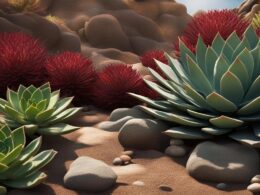Selecting drought-resistant plants for irrigation is a key strategy in conserving water, reducing maintenance costs, and promoting sustainability in gardening. By choosing plants that can withstand periods of limited water availability, you can create beautiful and thriving landscapes while minimizing the need for excessive irrigation. In this article, we will explore the importance of drought tolerance, the characteristics of drought-tolerant plants, and popular options for different regions in the US.
Key Takeaways:
- Drought-resistant plants are crucial for water conservation and reducing maintenance costs in gardening.
- These plants can thrive with minimal irrigation and withstand periods of limited water availability.
- Characteristics of drought-tolerant plants include adaptations like thick and waxy leaves or extensive root systems.
- Drought-prone regions in the US include the western half, but recent dry years have also affected the Northeast and Mid-Atlantic.
- Native plants from dry regions are often drought-tolerant, but research is important for selecting suitable plants for specific climates and site conditions.
Where do droughts occur in the US?
Droughts are more common and severe in the western half of the United States. States such as California, Arizona, Nevada, and New Mexico have experienced prolonged periods of drought due to their arid climate and limited water sources. These regions are known to be drought-prone and face challenges in maintaining water supplies for agriculture, residential use, and environmental conservation.
However, recent years have also seen an increase in drought occurrence in the Northeast and Mid-Atlantic regions. States like Massachusetts, Connecticut, New York, and Maryland have experienced drought conditions due to shifts in weather patterns and reduced precipitation. These areas, typically known for their abundant rainfall, are now facing water scarcity issues and the need for water conservation measures.
It is important to understand the varying levels of drought vulnerability across different areas in order to make informed decisions regarding water usage, landscaping practices, and plant selection. By assessing the specific drought-prone regions, individuals can adapt their gardening techniques and choose drought-tolerant plants that are well-suited to withstand the challenges of limited water availability.
Table: Drought Occurrence in the US
| Region | Drought-Prone States |
|---|---|
| Western | California, Arizona, Nevada, New Mexico |
| Northeast | Massachusetts, Connecticut, New York |
| Mid-Atlantic | Maryland, Delaware, New Jersey |
How does drought-tolerant landscaping help?
Drought-tolerant landscaping is a key strategy in water conservation efforts and sustainable landscaping practices. By opting for drought-tolerant plants in your landscape design, you can significantly reduce water usage and promote a more environmentally friendly approach to gardening. This not only helps conserve precious water resources, but also lowers your irrigation requirements, resulting in cost savings and reduced maintenance.
Drought-tolerant plants have unique adaptations that enable them to thrive in water-limited environments. These plants often have characteristics such as thick and waxy leaves, which help trap moisture and reduce water loss through evaporation. They may also have small or thin leaves that minimize surface area exposed to hot air, reducing water requirements. Additionally, many drought-tolerant plants have extensive root systems that allow them to access moisture deep in the soil, making them more resilient during dry spells.
By incorporating drought-tolerant plants into your landscaping, you can create visually appealing outdoor spaces that require less water. This can be especially beneficial in regions with limited water resources or areas prone to drought. Drought-tolerant landscaping not only helps reduce water usage, but also fosters a more sustainable and environmentally conscious approach to gardening. With proper planning and plant selection, you can create a beautiful and thriving landscape while minimizing your impact on water resources.
Benefits of Drought-Tolerant Landscaping:
- Conserves water resources
- Reduces irrigation requirements
- Lowers maintenance costs
- Promotes sustainability in gardening
- Creates visually appealing outdoor spaces
- Thrives in regions with limited water resources
Drought-tolerant landscaping not only benefits the environment, but also provides an opportunity to create unique and beautiful outdoor spaces. By embracing water-conserving practices and selecting plants that can withstand periods of limited water availability, you can contribute to a more sustainable future while still enjoying a vibrant and thriving landscape.
What does “drought tolerant” mean?
“Drought tolerance” refers to a plant’s ability to survive and thrive during periods of water scarcity. Drought-tolerant plants are able to withstand limited precipitation and can thrive even with less water than their natural environment usually provides. It is important to note that not all drought-tolerant plants are completely resistant to drought, but they can tolerate and thrive in drier conditions compared to high-water plants.
Drought tolerance is an important adaptation for plants in regions with water scarcity or periodic droughts. These plants have evolved various mechanisms to cope with limited water availability, allowing them to survive and continue their life cycles despite the challenging conditions. By conserving water and adjusting their physiological processes, drought-tolerant plants can maintain their essential functions and reduce water loss, enabling them to endure extended periods without significant rainfall.
In addition to their ability to survive water scarcity, drought-tolerant plants play a crucial role in maintaining ecosystems and supporting biodiversity. They provide habitats and food sources for various organisms, including insects, birds, and mammals, contributing to the overall resilience and stability of ecosystems. By incorporating drought-tolerant plants into landscapes and gardens, we not only conserve water but also create sustainable environments that support local ecosystems and preserve ecological balance.
Drought-tolerant plants: Key characteristics
Drought-tolerant plants possess several key characteristics that enable them to thrive in water-limited environments. These adaptations help them conserve water and maximize their efficiency in utilizing available moisture. Some of the common characteristics of drought-tolerant plants include:
- Deep root systems: Drought-tolerant plants often have extensive root systems that can penetrate deeper into the soil to access water reserves that are not available to shallow-rooted plants.
- Thick and waxy leaves: These leaves are designed to trap moisture and reduce the rate of water loss through evaporation, helping plants retain water even in dry conditions.
- Small or thin leaves: By minimizing leaf surface area, drought-tolerant plants reduce the amount of water lost through transpiration, enabling them to conserve water while still performing photosynthesis.
- Reduced leaf surface: Some drought-tolerant plants have adapted to hot and dry conditions by developing leaves with a silvery or hairy texture, which shades the leaves and reduces contact with hot air, minimizing water loss.
- Water storage tissues: Certain plants have specialized tissues or structures that store water, allowing them to access stored moisture during prolonged dry spells.
| Drought-Tolerant Plant | Characteristics |
|---|---|
| Agave | Thick, fleshy leaves; water-storing tissues |
| Lavender | Silvery foliage; reduced leaf surface |
| Yucca | Deep root system; water-storing tissues |
| Sedum | Small, succulent leaves; water-storing tissues |
What Makes a Plant Drought Tolerant?
Drought-tolerant plants possess various adaptations that enable them to thrive in water-limited environments. These adaptations are their natural strategies for conserving water and ensuring their survival during drought periods. Understanding these characteristics can help you select the right plants for your drought-tolerant garden.
Adaptations for Water Conservation
Drought-tolerant plants have evolved distinct features that aid in water conservation. Some of these adaptations include:
- Thick and waxy leaves: These leaves help to trap moisture and reduce water loss through evaporation.
- Small or thin leaves: Plants with small or thin leaves have a reduced surface area, minimizing water loss through transpiration.
- Silvery or hairy foliage: Foliage with a silvery or hairy texture helps to shade the leaves and reduce contact with hot air, reducing water loss.
- Early leaf dropping: Some drought-tolerant plants shed their leaves in response to water scarcity, conserving resources.
- Extensive root systems: Drought-tolerant plants often develop deep and extensive root systems to access moisture deep within the soil.
These adaptations collectively enable drought-tolerant plants to thrive in drier conditions, making them ideal choices for water-conserving landscapes.
“Drought-tolerant plants have evolved various adaptations to cope with limited water availability.”
| Drought-Tolerant Plant Adaptations | Description |
|---|---|
| Thick and waxy leaves | Help to trap moisture and reduce water loss through evaporation |
| Small or thin leaves | Reduce water loss through transpiration by minimizing surface area |
| Silvery or hairy foliage | Shades leaves and reduces contact with hot air, decreasing water loss |
| Early leaf dropping | Conserves resources by shedding leaves in response to water scarcity |
| Extensive root systems | Access moisture deep within the soil during dry spells |
By recognizing the unique adaptations of drought-tolerant plants, you can make informed choices when selecting plants for your garden, ensuring their resilience and water efficiency.
Are native plants drought-tolerant?
Native plants are often associated with being drought-tolerant due to their adaptation to arid conditions. However, it is important to note that not all native plants automatically possess drought tolerance. The ability to withstand limited water availability varies among different species, and thorough research is essential when selecting plants for your garden.
Native plants from dry regions have evolved unique characteristics that enable them to thrive in water-limited environments. These characteristics include deep root systems that can access moisture deep in the soil, thick leaves that reduce water loss through evaporation, and the ability to go dormant during periods of prolonged drought. These adaptations allow native plants to survive and even flourish in arid conditions.
However, it is crucial to consider the specific drought tolerance characteristics of individual native plants. Factors such as soil type, sun exposure, and local climate conditions can influence a plant’s ability to withstand drought. Consulting with local gardening experts, nurseries, or extension offices can provide valuable insights and recommendations for native plants that are well-suited to your specific region.
| Native Plants | Drought Tolerance |
|---|---|
| Agave americana | High |
| Yucca filamentosa | High |
| Penstemon eatonii | Moderate |
| Ceanothus spp. | High |
By selecting native plants with proven drought tolerance and understanding their specific needs, you can create a sustainable and water-efficient garden that celebrates the beauty and resilience of the local ecosystem.
Do I need to irrigate a drought-tolerant garden?
While drought-tolerant plants are known for their ability to withstand limited water availability, it is important to provide supplemental irrigation during their establishment period. This initial watering helps the plants develop strong root systems, which in turn enable them to thrive with minimal irrigation in the long run.
Once the drought-tolerant plants are established, they have adapted to survive with less water. However, it is crucial to monitor and adjust irrigation practices based on factors such as soil moisture levels, weather conditions, and plant requirements. This way, you can ensure that your garden continues to flourish while conserving water.
When it comes to irrigating a drought-tolerant garden, it is essential to focus on water-efficient practices. One effective technique is deep watering, where you provide a thorough soak to the plant roots, encouraging them to grow deep and access moisture from the lower soil layers. It is also advisable to water less frequently but deeply, rather than shallow and frequent watering, as this promotes healthier root development and reduces water loss through evaporation.
Drip Irrigation: A Water-Efficient Solution
A highly recommended irrigation method for drought-tolerant gardens is drip irrigation. This system delivers water directly to the plant roots, minimizing evaporation and ensuring efficient water usage. By placing drip emitters near the base of each plant, you can provide water precisely where it is needed, reducing wastage.
Regular inspections of the irrigation system are crucial to detect and repair any leaks or malfunctions promptly. By addressing issues promptly, you can prevent water loss and ensure that your drought-tolerant garden remains healthy and vibrant.
| Irrigation Tips for Drought-Tolerant Gardens |
|---|
| Water deeply but less frequently to encourage strong root growth. |
| Avoid watering foliage and focus on the base of the plants to prevent water waste. |
| Time your watering sessions for early morning or late afternoon to minimize evaporation. |
| Monitor soil moisture levels and only water when necessary to prevent overwatering. |
| Apply mulch around plants to retain moisture and reduce water evaporation. |
By following these irrigation techniques and adopting water-efficient practices, you can ensure that your drought-tolerant garden thrives with minimal water usage. This not only helps conserve water but also reduces maintenance costs and contributes to sustainable gardening practices.
Popular Drought-Tolerant Plants by Region
Choosing the right drought-tolerant plants is essential for creating thriving landscapes that can withstand limited water availability in different regions of the US. Here are some popular options for drought-tolerant plants by region:
California:
In California, popular choices for drought-tolerant plants include Quercus agrifolia (California live oak) and Ceanothus ‘Concha’ (California lilac). These plants are well-adapted to the Mediterranean climate of California and can thrive with minimal watering once established.
Texas:
In the hot and dry climate of Texas, Quercus macrocarpa (bur oak) and Salvia greggii (autumn sage) are excellent choices for drought-tolerant landscaping. These plants have adapted to Texas’ arid conditions and can withstand periods of limited water availability.
Southwest:
In the Southwest region, Chilopsis linearis (desert willow) and Fallugia paradoxa (Apache plume) are popular drought-tolerant plant options. These native plants are well-suited to the arid climate of the Southwest and can add beauty to your landscape while conserving water.
| Region | Recommended Drought-Tolerant Plants |
|---|---|
| Utah and Mountain areas | Quercus gambelii (Gambel oak) and Arctostaphylos patula (greenleaf manzanita) |
| Mid-Atlantic | Baptisia australis (blue false indigo) and Panicum virgatum (switchgrass) |
| Florida | Myrcianthes fragrans (simpson stopper) and Aptenia ‘Red’ (heartleaf iceplant) |
When selecting drought-tolerant plants for your region, it’s important to consider not only their ability to withstand limited water availability but also their suitability to local climate and site conditions. By choosing plants that are well-adapted to your region, you can create a beautiful and water-efficient landscape that thrives even in drought-prone areas.
Irrigation Techniques and Tips for Drought-Tolerant Plants
Proper irrigation is essential for the care and maintenance of drought-tolerant plants. While these plants can withstand limited water availability, they still require some watering, especially during their establishment period. By following the right techniques, you can ensure the health and vitality of your drought-tolerant garden while conserving water and promoting sustainable practices.
Watering Guidelines
When watering drought-tolerant plants, it is important to strike a balance between providing enough moisture for their growth and avoiding overwatering. Here are some guidelines to follow:
- Water deeply but less frequently. This encourages the development of deep root systems, which allow plants to access water from lower soil layers.
- Avoid wetting the foliage and focus on watering the base of the plants. This reduces the risk of fungal diseases and helps direct water to the roots where it is needed the most.
- Water during cooler periods of the day, such as early morning or late afternoon. This reduces water loss due to evaporation and allows plants to absorb the moisture more effectively.
- During the establishment period, when plants are young and developing roots, provide more frequent watering to help them establish strong root systems.
Additionally, applying a layer of organic mulch around the base of your plants can help retain moisture in the soil, reduce weed growth, and regulate soil temperature. Mulch also acts as a barrier, preventing excessive evaporation and reducing the need for frequent watering. Remember to regularly inspect your watering systems for leaks and adjust watering frequency based on weather conditions and the specific needs of your plants.
Table: Recommended Watering Frequencies for Drought-Tolerant Plants
| Plant Type | Watering Frequency | Comments |
|---|---|---|
| Succulents and Cacti | Once every 2-4 weeks | Allow the soil to dry out between waterings |
| Native Grasses | Once every 1-2 weeks | Water deeply to encourage deep root growth |
| Drought-Tolerant Shrubs | Once every 1-2 weeks | Adjust frequency based on weather and soil conditions |
| Drought-Tolerant Trees | Once every 2-3 weeks | Water deeply to promote healthy root development |
By implementing these irrigation techniques and following the recommended watering guidelines, you can ensure the success of your drought-tolerant garden. Remember to monitor your plants’ response to watering and adjust as necessary to provide the right amount of moisture for their specific needs. With proper care and attention, your drought-tolerant plants will thrive and contribute to a sustainable and resilient landscape.
Conclusion
The selection of drought-resistant plants for irrigation is a crucial step towards creating sustainable and water-efficient landscapes. By choosing plants that exhibit drought tolerance, you can reduce water consumption, lower maintenance costs, and contribute to overall environmental conservation.
Opting for drought-resistant plants not only promotes water conservation but also enhances the beauty and resilience of your garden. These plants have evolved adaptations that allow them to thrive in water-limited environments, making them ideal for sustainable landscaping.
To ensure the success of your drought-resistant garden, it is important to optimize your irrigation practices. Water deeply but less frequently, targeting the base of the plant to encourage deep root growth. Avoid watering during the hottest periods of the day and consider using water-efficient irrigation systems such as drip irrigation.
By understanding the characteristics of drought-resistant plants and selecting appropriate species for your region, you can create thriving landscapes while conserving water resources. Embracing drought tolerance in your gardening practices is a significant step towards a more sustainable and environmentally conscious future.
FAQ
Where do droughts occur in the US?
Droughts are more common and severe in the western half of the United States. However, recent dry years have also brought drought tolerance into the conversation in the Northeast and Mid-Atlantic regions.
How does drought-tolerant landscaping help?
Drought-tolerant landscaping helps conserve water by reducing the need for excessive irrigation. By opting for plants that can withstand limited water availability, we can significantly reduce water consumption, conserve resources, and promote a more sustainable approach to landscaping.
What does “drought tolerant” mean?
“Drought tolerance” refers to a plant’s ability to survive and thrive during periods of water scarcity. Drought-tolerant plants can withstand limited precipitation and thrive with less water than their natural environment usually provides.
What makes a plant drought tolerant?
Drought-tolerant plants have various adaptations to cope with limited water availability. These adaptations include thick and waxy leaves, small or thin leaves, silvery or hairy foliage, early leaf dropping, and extensive root systems. These characteristics enable drought-tolerant plants to thrive in water-limited environments.
Are native plants drought tolerant?
While many native plants from dry regions have evolved to be drought-tolerant, not all native plants are automatically drought-tolerant. It is important to research and select plants based on their specific drought tolerance characteristics and suitability to the local climate and site conditions.
Do I need to irrigate a drought-tolerant garden?
Drought-tolerant plants still need supplemental watering during their establishment period. Once they develop strong root systems, they can thrive with minimal irrigation. However, new plants require more water during the establishment period. It is important to follow proper irrigation techniques and water-efficient practices.
What are popular drought-tolerant plants by region?
Popular drought-tolerant plants vary by region. In California, Quercus agrifolia and Ceanothus ‘Concha’ are popular choices. In Texas, Quercus macrocarpa and Salvia greggii are recommended. In the Southwest, Chilopsis linearis and Fallugia paradoxa are popular. In Utah and Mountain areas, Quercus gambelii and Arctostaphylos patula are commonly used. In the Mid-Atlantic, Baptisia australis and Panicum virgatum are popular options. In Florida, Myrcianthes fragrans and Aptenia ‘Red’ are recommended.
What are irrigation techniques and tips for drought-tolerant plants?
When irrigating drought-tolerant plants, it is important to water deeply but less frequently, avoid foliage and target the base of the plant, and time watering during cooler periods of the day. New plants require more water during the establishment period, and mulching can help retain moisture. Following these guidelines will promote the successful growth of drought-tolerant plants.
Why should I select drought-resistant plants for irrigation?
Selecting drought-resistant plants for irrigation is essential for sustainable landscaping and water conservation efforts. By choosing plants that exhibit drought tolerance, we can create beautiful and resilient gardens that require less water, reduce maintenance costs, and contribute to overall environmental sustainability.














